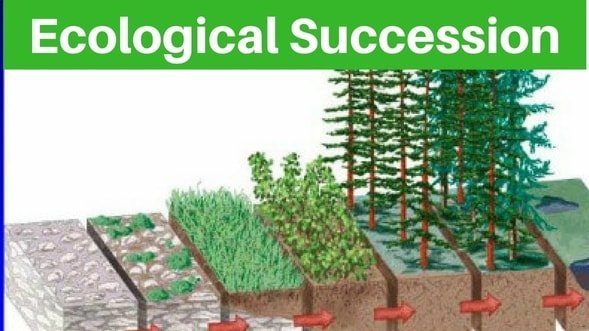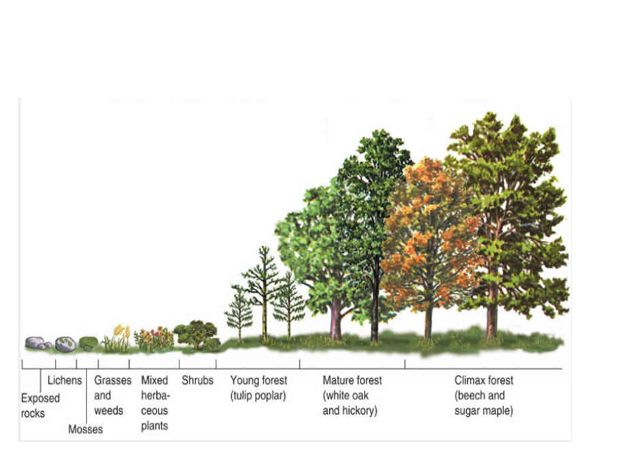Back to: BIOLOGY SS2
Welcome to Class !!
We are eager to have you join us !!
In today’s Biology class, We will be learning about Ecological Succession. We hope you enjoy the class!

CONTENT
- Introduction
- Types of Succession
- Differences Between Successions
- Characteristics of Succession
- Outcome of Succession
ECOLOGICAL SUCCESSION
The orderly change in the inhabitants of an area over time is called succession. It can also be defined as the step by step orderly and gradual replacement of communities of organisms that lead to a climax community.
An illustration of succession is that of a pond. Rain carries sediment from surrounding land into the pond, filling it and making it shallower. Algae that live in the pond die and eventually fall to the bottom, adding organic materials to the sediment.
Some plants such as pondweeds grow at the bottom. These plants make up the pioneer community. The pioneer plants are the first to inhabit the changing environment. The roots of these underwater plants hold much silt, quickly building up the bottom cover of the pond. As they die, their organic matter accumulates at the bottom. The water along the edges becomes so shallow that water lilies and other floating plants replace the pioneer plants.
The final stage of succession in a particular area is called the climax community. The species that constitute the climax community differs from biome to biome. A climax community is also a stable community because its appearance and species composition are stable. To become climax, the community would have gone through a sequence of species.

TYPES OF SUCCESSION
Basically, there are two types of succession; these are
- Primary succession
- Secondary succession
PRIMARY SUCCESSION
This is a type of succession that begins from bare ground, bare rock or bare body of water.
Primary succession on land may be studied on a building site where a heap of sub-soil, stones or cement block is left over after construction. In an aquatic habitat, primary succession may be observed in a new artificial pond.
The first in any succession are called primary colonizers and are usually autotrophic plants. These have simple requirements for life and can withstand exposures. By the second year of the primary succession in addition to more algae and lichens, mosses may begin to grow. As they grow, they wear out some soil and some of them die and decay, creating more soil for their successor.
By the third year, small herbaceous plants may be present. These, in turn, help to change the habitat by overshadowing the smaller plants, causing them to die out and dropping their leaves, and thus making the soil suitable for other organisms. As years pass by, more species come into the habitat, while some face out. The succession of species continues until the climax is reached. Then, bigger life forms like shrubs and trees are found growing.
SECONDARY SUCCESSION
Secondary succession is a succession that occurs when an area has not been totally stripped of soil and vegetation. It occurs more rapidly than primary succession because the soil has already been formed. It also occurs when a farmer abandons an old field. Secondary succession begins from an existing community which has been interfered with by man and other factors. Fire, drought and floods can cause secondary succession.

EVALUATION
- Define a pioneer community.
- How is a stable community reached?
DIFFERENCES BETWEEN PRIMARY AND SECONDARY SUCCESSION
| PRIMARY SUCCESSION | SECONDARY SUCCESSION | |
| 1 | Starts on a bare surface | Starts on already colonized surface |
| 2 | It is slower or takes a longer time to reach a climax community | It is faster or takes a shorter time to reach a climax community |
| 3 | Starts with lower organisms | Starts with fairly complex organisms |
CHARACTERISTICS OF SUCCESSION
- Plants form pioneer organisms being the producers
- The number of organisms is usually increased from year to year until a climax is reached.
- Diversity of organisms species increase from year to year.
- Succession is orderly and progressive starting with microscopic green plants and ending with big trees.
- Each generation of species alters the habitat by making more soil, and when they die the soil becomes more fertile.
- There is competition among organisms in that the various species present compete for the available resources such as water, CO2, O2, light and space. The plants that are more able to compete displace others.
- Changes in species composition as the fittest survive and the unfit fade out.
OUTCOME OF SUCCESSION
- Changes in the physical environment due to structural changes of the species and the activities in the community.
- Simple organisms which start the succession are usually replaced by more complex ones in an evolutionary trend
- The equilibrium point is attained through colonization of abandoned farmland by a wide variety of organisms
- The final outcome of succession is the climax or stable community.
GENERAL EVALUATION
- What is ecological succession?
- Write a short note on primary succession
- Differentiate between primary and secondary succession.
- Define stable community.
- State the outcome of succession.
READING ASSIGNMENT
College Biology, chapter 23, pages 537-540
WEEKEND ASSIGNMENT
SECTION A
- The change which occurs during ecological succession is A. sudden B. rapid C. gradual D. no change
- The pioneer community include any of the following except A. spirogyra B. water weeds C. trees D. lichen
- All these except one serves as the basis of primary succession already A. colonized habitat B. bare ground C. bare body of water D. bare rock
- The following except one are false about secondary succession A. starts on a bare surface B. It is slow C. starts with fairly complex organism D. takes longer time to reach a climax community
- One of these is a pioneer organism. A. Lichen B. liverwort C. Conifer D. Grass
SECTION B
- State five characteristics of ecological succession.
- State the two types of ecological succession
- Differentiate between the two successions.
We have come to the end of this class. We do hope you enjoyed the class?
Should you have any further question, feel free to ask in the comment section below and trust us to respond as soon as possible.
In our next class, we will be learning about Overcrowding and Food Shortage. We are very much eager to meet you there.

Very Confidential and good.
I love it 😍😍❤️ 😍❤️💙😍😍❤️💙